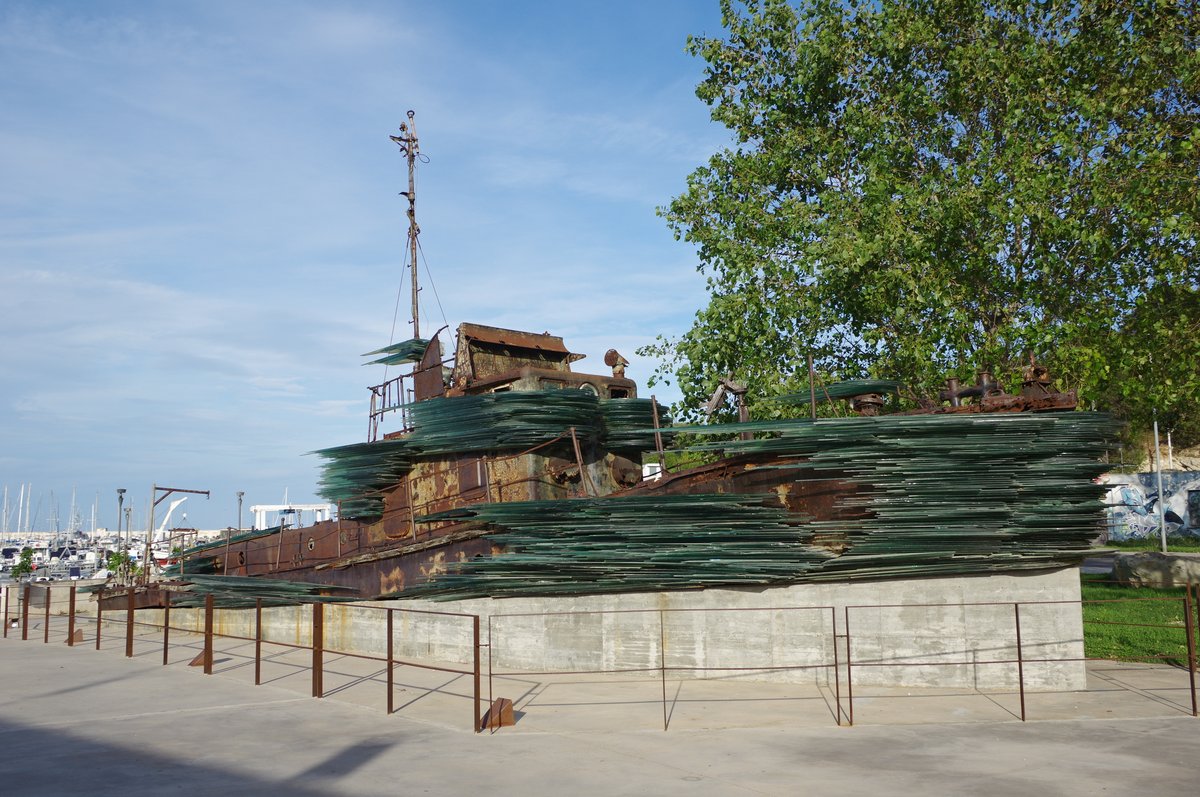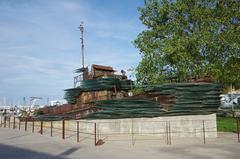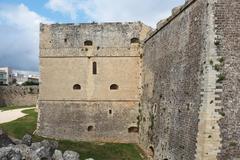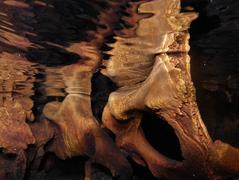
L’Approdo. Opera All’Umanità Migrante, Katër i Radës Memorial, and Otranto: Visiting Hours, Tickets, and Historical Significance
Date: 14/06/2025
Introduction
At the easternmost tip of Italy, Otranto stands as a historic and symbolic gateway between East and West. With its medieval architecture, dramatic coastline, and centuries-old role as a crossroads of cultures, Otranto is also home to two profound contemporary landmarks: L’Approdo. Opera All’Umanità Migrante and the Katër i Radës Memorial. These sites commemorate the experiences of migrants across the Mediterranean and honor the memory of lives lost in the quest for safety and new beginnings.
This detailed guide explores the historical and cultural significance of these monuments, provides practical visiting information—including hours, ticketing, and accessibility—and suggests how to integrate them into a broader exploration of Otranto’s rich heritage.
Table of Contents
- Overview: Otranto’s Role as a Gateway
- L’Approdo. Opera All’Umanità Migrante
- Katër i Radës Memorial
- Exploring Otranto
- Frequently Asked Questions (FAQ)
- Suggested Visuals and Media
- Conclusion
- References and Further Reading
Overview: Otranto’s Role as a Gateway
Otranto’s history is a tapestry woven from Greek, Roman, Byzantine, Norman, and Ottoman influences (Beautiful Puglia). Its seafront is not just a scenic backdrop but a witness to stories of war, migration, and cultural exchange. In recent decades, Otranto has become a focal point in the Mediterranean migration narrative, marked by both hope and tragedy.
L’Approdo. Opera All’Umanità Migrante
Historical Context
Commissioned in 2011 and created by renowned artist Costas Varotsos, L’Approdo. Opera All’Umanità Migrante (“The Landing. Work to Migrant Humanity”) stands as a contemporary monument on Otranto’s waterfront. The sculpture’s location, at Punta Palascìa—the easternmost point of Italy—underscores Otranto’s historic role as an arrival and departure point for countless migrants (Comune di Otranto).
Artistic Vision and Symbolism
Varotsos’s installation is a monumental arc, approximately 4 meters high and 12 meters long, constructed from stacked glass sheets and a steel frame. The transparency and fragility of glass represent both the vulnerability and resilience of migrants, while the arc form suggests passage, bridging land and sea. Facing the Strait of Otranto, the sculpture invites reflection on journeys—both physical and symbolic.
An inscription at the base reads “Opera all’Umanità Migrante,” evoking universal solidarity. Annual commemorations and educational programs use the site to discuss migration, human rights, and the permeability of borders (Pressinbag).
Cultural Significance
L’Approdo is now an iconic part of Otranto’s identity, complementing its UNESCO-listed historic center, the Cathedral of Santa Maria Annunziata and its mosaics, and the Aragonese Castle. The sculpture bridges the city’s medieval past and its contemporary humanitarian consciousness, serving as a platform for art, memory, and civic engagement (Beautiful Puglia).
Visiting Hours, Tickets, and Accessibility
- Hours: Open 24/7, year-round, as an open-air public artwork.
- Tickets: No admission fee; access is entirely free.
- Location: Seafront promenade, 5–10 minutes’ walk from Otranto’s historic center.
- Accessibility: The site is wheelchair accessible, with smooth paths along Lungomare degli Eroi. Some minor uneven surfaces near the water may require caution.
Visitor Experience and Practical Tips
- Best Time to Visit: Early morning or late afternoon for optimal lighting and fewer crowds. The installation is also evocatively illuminated at night.
- Guided Tours: Available through local agencies and the tourist office, often combined with other historic sites.
- Amenities: Restaurants, cafés, and public restrooms are nearby in the old town.
- Etiquette: Photography is encouraged; please respect the contemplative nature of the site.
Katër i Radës Memorial
Historical Background
On Good Friday, March 28, 1997, the Albanian patrol boat Katër i Radës—overloaded with migrants fleeing turmoil in Albania—collided with the Italian naval corvette Sibilla while attempting to reach Italy. The disaster resulted in the loss of 81 lives, including many women and children. This event, known as the “Strage del Venerdì Santo” (Good Friday Massacre), became a stark symbol of the risks migrants face and the costs of border enforcement (InTheNet).
Memorial Significance and Visitor Information
The Katër i Radës memorial, constructed from the salvaged hull of the vessel and fragments of glass, stands near Otranto’s port. It is a space for remembrance, reflection, and ongoing dialogue about migration.
- Visiting Hours: Daily from 9:00 AM to 7:00 PM (check official sites for seasonal updates).
- Tickets: Free entry. Guided tours, offering deeper historical context, are available for a nominal fee.
- Accessibility: Wheelchair accessible.
- Special Events: Annual commemorations on March 28, with ceremonies, art performances, and educational workshops.
Exploring Otranto
Historical Sites
- Otranto Cathedral (Basilica Cattedrale di Santa Maria Annunziata): Famous for its 12th-century mosaic floor and the Chapel of the Martyrs. Open daily, free entrance, with guided tours available (Winalist).
- Castello Aragonese: A post-Ottoman-invasion fortress with exhibitions and panoramic views. Ticketed entry.
- Porta Alfonsina: The main entrance to the historic center; open access.
- Otranto Old Town: Charming streets, artisanal shops, and vibrant local life.
Beaches and Natural Attractions
- Baia dei Turchi: Blue Flag beach, ideal for swimming, accessible by shuttle or car.
- Cava di Bauxite: Scenic former quarry with emerald waters.
- Punta Palascìa Lighthouse: Italy’s easternmost point, offering breathtaking sunrises.
Cultural Events and Practical Tips
- Best Time to Visit: Spring and early autumn offer milder weather and fewer crowds.
- Getting Around: Otranto is walkable; a car is helpful for beaches and outlying sites.
- Dining and Accommodation: Enjoy Apulian cuisine and a range of lodging options, from boutique B&Bs to countryside masserie.
- Events: The Festa dei Martiri di Otranto in August celebrates the city’s history with cultural festivities.
Frequently Asked Questions (FAQ)
Q: What are the visiting hours for L’Approdo and Katër i Radës memorial?
A: L’Approdo is accessible 24/7. The Katër i Radës memorial is open daily from 9:00 AM to 7:00 PM.
Q: Is there an entrance fee?
A: Both sites are free to visit; guided tours may require a ticket.
Q: Are the sites accessible for people with disabilities?
A: Yes, both L’Approdo and the Katër i Radës memorial are wheelchair accessible.
Q: How do I reach these sites from Otranto’s center?
A: Both are within walking distance from the historic center, along the seafront promenade.
Q: Are guided tours available?
A: Yes, through local tourism agencies and the visitor center.
Q: What else should I see in Otranto?
A: Don’t miss the cathedral, Castello Aragonese, Porta Alfonsina, and Baia dei Turchi.
Suggested Visuals and Media
- Images:
- L’Approdo sculpture at sunset with the Adriatic Sea (alt: “L’Approdo sculpture at sunset in Otranto”)
- Katër i Radës memorial and interpretive panels (alt: “Katër i Radës memorial in Otranto”)
- Otranto Cathedral mosaics (alt: “Otranto Cathedral mosaic floor”)
- Castello Aragonese fortress (alt: “Castello Aragonese in Otranto”)
- Baia dei Turchi beach (alt: “Baia dei Turchi beach blue waters”)
- Maps:
- Highlighting the locations of L’Approdo, Katër i Radës memorial, and other attractions.
- Interactive Media:
- Virtual tour or embedded map for planning your route.
Conclusion
L’Approdo and the Katër i Radës memorial are not only artistic landmarks but also sites of profound memory and reflection. They invite visitors to engage with Otranto’s layered history and the continuing stories of migration that shape the Mediterranean. Together with the city’s cathedral, castle, and scenic coastline, these monuments make Otranto a destination rich in meaning and beauty.
Plan your visit with this guide, immerse yourself in Otranto’s heritage, and contribute to the ongoing dialogue about migration, memory, and humanity. For updated information, guided tours, and cultural events, download the Audiala app and consult official tourism resources.
References and Further Reading
- Beautiful Puglia
- Comune di Otranto
- Pressinbag
- InTheNet
- The Globetrotting Teacher
- Our Escape Clause
- Winalist
- Trip101


